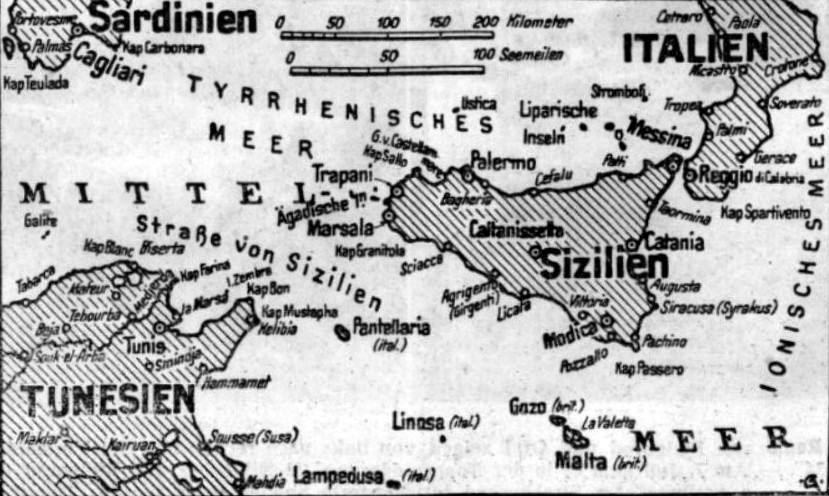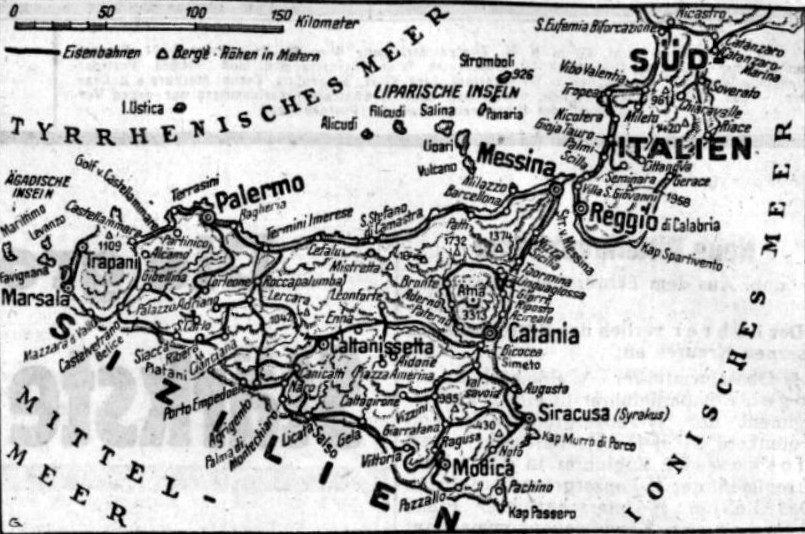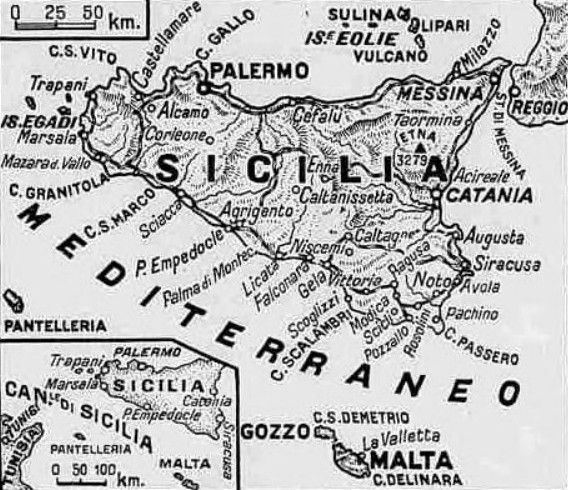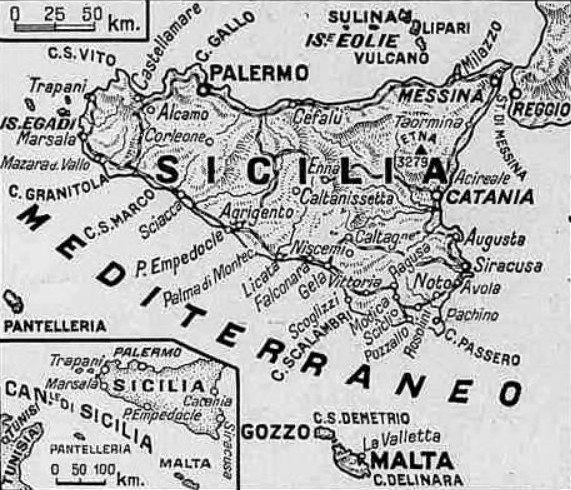The Pittsburgh Press (July 14, 1943)
YANKS CAPTURE AXIS BASE
British drive nearer to Catania; warships aid Americans in South Sicily; fliers pound enemy
Yanks smash 10 Nazi tanks
By Virgil Pinkley, United Press staff writer
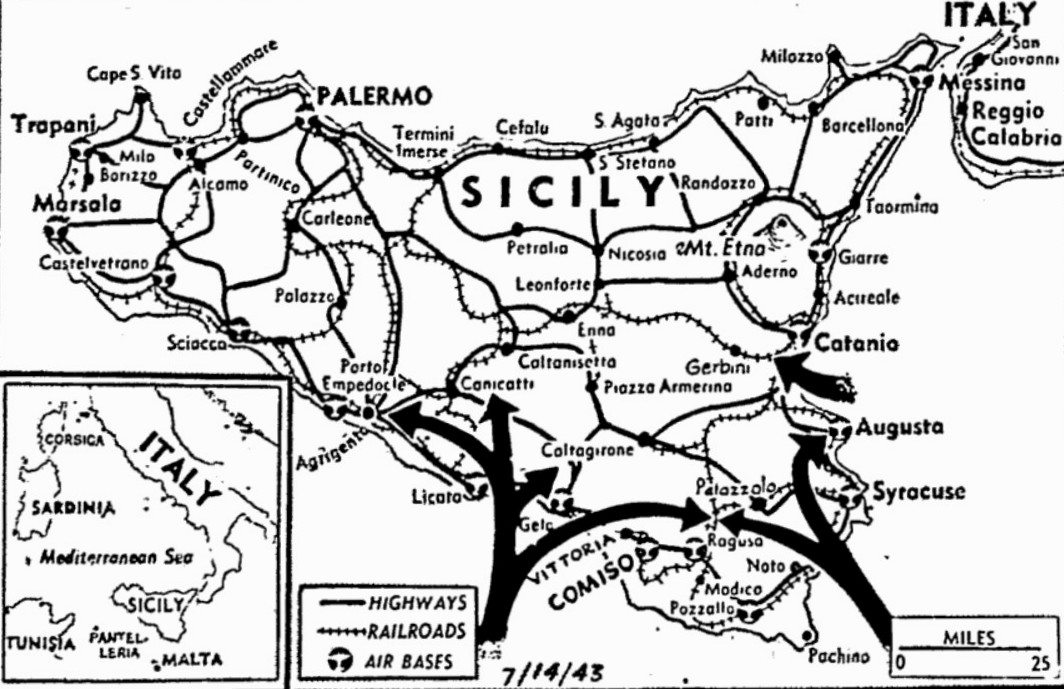
Yanks advance of 6-10 miles in South Sicily was announced today as British forces pushed up the east coast toward Catania. Catania was shelled and successful landings, presumably near Catania, were reported. U.S. forces are striking up to the east and west from the Licata-Gela area. They captured the important Axis base at Comiso.
Allied HQ, North Africa –
U.S. forces, supported by U.S. warship bombardments, smashed forward 6-10 miles in South Sicily and captured the important Axis base at Comiso today while British assault troops pressed up the eastern coast toward shell-pitted Catania.
Axis resistance appeared to be stiffening but the Americans under Lt. Gen. George S. Patton Jr. hammered their way into Naro, Palma and Ponte Olivo following a junction with the Canadians at captured Ragusa, and were reported about 30 miles inland at some points.
12 miles from Agrigento
The U.S. advance from Licata through Palma and to Naro put the Allies within 10 or 12 miles of the important Axis base at Agrigento. This gain, which was at the western end of the Allied front, have the Americans command of roads running northward to Canicattì.
The Americans knocked out 10 Nazi tanks in repulsing counterattacks by Italians and by the Hermann Göring Division northwest and northeast of Gela.
The capture of Naro and Comiso was believed to have greatly improved the American position in the south, where the hardest fighting so far had centered around Gela. The Americans were thrown back there, but rallied to advance against Italian and German counterattacks.
Hold mountain roads
Their latest gains consolidated their grip on the mountain toads and provided bases for thrusts northward from the Comiso-Ragusa area.
The Americans who took Ponte Olivo pushed some six miles inland from Gela, while other units drove 10 miles inland to a point two miles south of Buscemi, on the road to Caltagirone, an important inland road junction. The situation around Vittoria, which is just west of Comiso, was obscure but Allied units had reached the outskirts.
On the east coast, where Allied warships and air squadrons battered Catania Airport, the British had not yet reported big-scale enemy counterattacks. It was said there was no fighting as yet in or immediately around Catania, which has not been captured by the Allies. The town of Melilli was also reported still in Axis hands, although it was bypassed by the British coastal forces that captured the big naval base at Augusta today.
Catania Airport shelled
Catania Airport was shelled from the sea and smothered by many tons of aerial bombs, according to today’s communiqué, which said that disembarkation operations – which had previously been unofficially reported near Catania – “proceeded smoothly.” The points of disembarkation were not given in the communiqué.
While U.S. warships smashed Axis tank columns and airfields on the south coast of Sicily, the British and Canadian drive toward Catania smashed an entire Italian division and boosted the estimated number of prisoners to around 8,000, mostly Italians.
Axis broadcasts reported that big battles were developing in the mountains south of Catania, indicating that the Germans and Italians were making their most important stand so far.
Augusta shelled, taken
The communiqué said that Greek and British destroyers shelled the port of Augusta, main Italian naval base on the east coast, at 4 p.m. Monday and that Allied forces occupied that port early this morning.
The Augusta harbor facilities were almost intact and the Italian 206th Coastal Division was virtually destroyed in the operations on the east coast.
The Allies seized at least 2,000 more prisoners, mostly Italians, while a flotilla of MTBs (motor torpedo boats) operating in the Strait of Messina, engaged two Axis torpedo boats which were set ablaze and driven ashore. A third enemy boat was damaged but escaped.
U.S. warships supported U.S. troops under Gen. Patton, who were engaging enemy tank formations behind Gela and also bombarded the airfield at Ponte Olivo. U.S. warships then shelled enemy positions at Porto Empedocle, on the south coast of Sicily west of Agrigento.
Further general advances
The communiqué said there were further general advances in all sectors, following capture of Augusta, Ragusa and Naro, in southeast Sicily. U.S. and Canadian forces had made a junction yesterday at Ragusa, cutting off the whole southwestern tip of the island and seizing important communications centers.
U.S. forces in the Gela-Licata sector appeared to be encountering the strongest opposition and it appeared that the U.S. warship bombardments in the sector were an effort to aid in securing and extending the bridgehead as swiftly as possible.
On the east coast, the British 8th Army and Canadian units appeared to be making the greatest progress in their northward drive to the Catania plains.
Allied air fleets, including Flying Fortresses, provided a strong cover for the British advance up the east coast.
Curtain of firepower
“A swiftly moving curtain of firepower and bombs” hit the enemy in Sicily all day as the round-the-clock aerial attack was pressed, it was stated at headquarters.
The communiqué from headquarters of Gen. Dwight D. Eisenhower said:
The Navy’s main task of supporting the Army as commanding the sea and disembarking troops and their supplies continues.
Throughout the operations, U.S. warships have rendered valuable support to the troops on shore by engaging surrounding formations of tank columns behind Gela and, among other targets, the airfield at Ponte Olivo and enemy divisions at Porto Empedocle.
A British and a Greek destroyer entered the port of Augusta at 4 p.m. July 12. These ships, with the cruisers and monitors outside, assisted materially in the capture. The naval bombardment was described by the Army as both accurate and timely.
Disembarking smoothly
Catania Airfield was bombarded from the sea in the early hours of July 13. It was reported that the swell on some of the beaches has subsided. There were some bombing attacks on certain of the beaches and the vessels lying offshore, which did not interrupt the work in progress. Disembarkations proceeded smoothly.
There were signs of increased U-boat activity throughout the area, but countermeasures have been highly successful and disheartening to the enemy. Activity on the part of minesweepers and light coastal forces continues and efforts of all have been crowned with success.
The work of administrative units is of particular importance in operations of this nature, as a ceaseless flow of vehicles, ammunition and stores is being maintained through the ports and over beaches.
Axis broadcasts acknowledged the fall of Augusta and told of raids on Allied shipping in Augusta Harbor. From Stockholm came a report attributed to Axis sources that Gen. Montgomery’s main forces were within seven miles of Catania with advance guards even nearer.
A German broadcast quoted a Spanish dispatch as saying that 60 landing barges with an escort of destroyers steamed into the Mediterranean from Gibraltar yesterday and a convoy of nine vessels entered Gibraltar Harbor shortly afterward.
The message of Gen. Sir Bernard L. Montgomery, commander of the British 8th Army, to his troops on the eve of the invasion was revealed belatedly to have proclaimed that the time had now come to “carry the war into Italy and into the continent of Europe.”
Gen. Montgomery said:
The Italian overseas empire has been exterminated. We will now deal with the home country… We will set about the Italians in their own country in no uncertain way. They came into this war to suit themselves and they must take the consequences. They asked for it and now they’ll get it.
I have complete confidence in the successful outcome of this operation. Therefore, with faith in God and enthusiasm for our cause and for the day of battle, let us enter into this contest with stout hearts and a determination to conquer.
Planes blast 4 enemy ships
By Reynolds Packard, United Press staff writer
Allied HQ, North Africa –
Allied planes, supporting invasion armies with the greatest non-stop air offensive of the war, wrecked and damaged two supply ships, two destroyers, 320 trucks, six locomotives and 45 freight cars in 24 hours of attacks designed to paralyze the Axis defense of Sicily, it was announced today.
Supplementing new naval bombardments of Augusta and Catania, Sicilian east coast ports, Flying Fortresses from the Northwest African Air Forces literally rained bombs on the Catania Air Base, which an RAF statement described as “the most important Axis coastal air base.”
The Fortresses struck “directly ahead” of Gen. Sir Bernard L. Montgomery’s northward-driving 8th Army, the RAF said, and direct hits were scored on at least two large hangars. Dispersed aircraft were also wrecked.
Hit southern Italy
While the Northwest African Air Forces concentrated on Sicily, U.S. Liberators from the Middle East swept across the Mediterranean and dropped nearly 425,000 pounds of bombs on the Crotone and Vibo Valentia Airdromes in southern Italy. Three hangars were wrecked at Vibo Valentia.
Significantly, the Liberators met no fighter opposition over Crotone, supposedly a fighter base.
Utilizing virtually every unit in their command, the Northwest African Air Forces sank two more enemy merchant ships, heavily damaged two destroyers, wrecked 160 trucks, damaged an equal number and “reduced to scrap” six locomotives and 45 freight cars.
Forty-two Axis aircraft were shot of the skies, while Allied losses totaled only seven, a ratio of 6–1. Uncounted other enemy planes were wrecked on their airdromes.
Hit by torpedoes
The two heavily-laden merchant ships were sunk north of Sicily by torpedo-carrying Beaufighters.
U.S. A-36 Mustangs damaged two destroyers, also near Sicily.
Mitchells and Martin Marauders joined Fortresses in attacks on airfields, where hangars and administration buildings were set afire, and night intruder planes hammered Messina and Palermo and other communications centers throughout Sicily.
Twin-tailed Lightnings ranged the Sicilian skies at will, concentrating their firepower and the bombs tucked underneath their wings on trains, road transport and troops.
Even light and medium bombers joined in the many missions which wrought havoc among Axis concentrations, making it hard for the Germans and Italians to get set or start throwing punches.
Destroy 20 cars
One pack of Lightnings spotted 20 railroad cars, many believed to contain fuel, which were destroyed with bombs. Twenty more cars on a siding were reduced to rubble. At another point, three railroad cars and a warehouse were left aflame.
Diving out of the sun, one formation of Lightnings raked a barracks and left it burning. Two staff cars and four trucks parked in front of the barracks were set on fire. The formations gunned eight men in black uniform, probably Fascist officials or militiamen.
The attacks on shipping boosted the number of merchantmen sunk or damaged in 48 hours to seven and the number of Italian destroyers hit to four. A Royal Air Force statement asserted that the concentrated attacks on enemy shipping were frustrating desperate Axis attempts to reinforce its Sicilian garrisons.
Repel Axis planes
Fighters carried out dawn-to-dusk sweeps over the invasion area beaches and shipping and drove off enemy aircraft attempting to interfere with the steady progress of ground forces.
Fighter-bombers swept low over the enemy rear, shelling and machine-gunning troop columns, transport and communications, wrecks of tanks and armored vehicles littered the winding Sicilian roads.
Hit enemy fields
Heavy bombers smashed at the Milo and Catania Airdromes and medium bombers dropped their cargoes of explosives on Enna, a communications center.
Torpedo planes caught the two merchant vessels and two destroyers off the north coast of Sicily in the same area where seven enemy vessels were sunk or damaged only 24 hours earlier.
Axis airfields and communications were also attacked by bombers Monday night and intruder planes struck at targets in both Sicily and southern Italy.
Night fighters accounted for 11 of the 42 enemy planes shot down during the 24-hour period.
